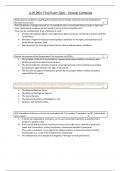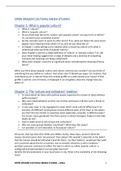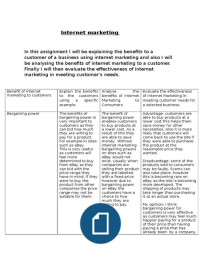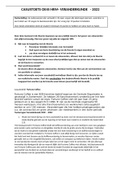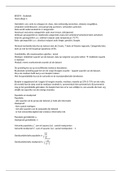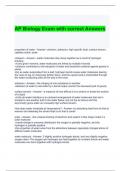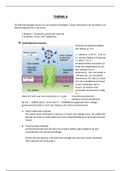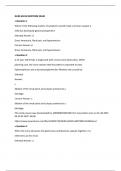What general conditions regarding the employment of foreign nationals does the Employment
Services Act set out? 3
The ESA defines a ‘foreign national’ as “an individual who is not a South African citizen or does not
have a permanent residence permit issued in terms of the Immigration Act.”
They may be employed but their employment must:
Comply with and give effect to the right to fair labour practices contained in section 23 of the
Constitution;
Not have a negative impact on existing labour standards or the rights and expectations of
South African workers; and
Must promote the training of South African citizens and permanent residents.
Explain the purpose of the Employment Tax Incentive Act (ETIA). 2
The purpose of the Act is to provide for a government-wage subsidy to employers who
employ young and inexperienced workers.
The Act provides for subsidies aimed at encouraging private sector employers to employ
young people aged between the ages of 18 and 29.
The Act aims to support employment growth by focussing on labour market activation,
especially for the youth.
The EEA specifically excludes certain categories of workers from its application. List the 5 categories
of workers who are excluded from the application of the EEA. 5
The National Defence Force;
The National Intelligence Agency;
The Secret Service;
The National Academy of Intelligence; and
Directors and staff of Comsec.
Will X be able to enforce a contract he concluded with Z, to murder Z's business rival B? Substantiate
your answer. 3
X will be an independent contractor, as he was contracted to perform a specified task /
produce a specific result.
X will not be able to enforce a contract in terms of the LRA, but is entitled to protection
under the Constitution, as the Constitution is broad and extends to everyone.
Thus, even a murderer, has a right to fair labour practices in terms of section 23 of the
Constitution as a result of the employment relationship.
This relationship exists despite the illegality of the type of work performed.
, What number of months/weeks does the BCEA prescribe for maternity leave and sick leave? 2
Maternity Leave
o An employee is entitled to four consecutive month’s maternity leave.
o An employee may not work for six weeks after the birth of her child.
o If an employee miscarries in the third trimester of the pregnancy or has a still born
child, she is entitled to six weeks’ leave after the miscarriage or still birth.
Sick Leave
o Six weeks’ paid sick leave in every three-year cycle worked
List the different ways in which contractual terms and conditions of employment can be changed. 5
By agreement between the employer and the employee or in line with the method
prescribed in the contract of employment;
By means of a collective agreement between the employer and a trade union/s;
By operation of law, for example, the BCEA; and
Through a sectoral determination issued by the MoL.
Write a short note on the importance of the distinction between an employee and an independent
contractor within the labour law context. 4
The primary aim of the LRA is to promote sound relations between employers and
employees in the workplace.
Workers who are not employees fall outside the scope of the LRA and are, amongst others,
not entitled to protection against unfair dismissal.
For this reason, it is important to be able to draw a distinction between employees and other
workers who do not qualify as employees, so called ‘independent contractors’.
People not covered by labour laws will not be protected and will have to find other laws to
protect themselves.
Write a short note on the difference between direct and indirect discrimination.
Direct discrimination
o It occurs if someone is clearly treated differently because of a certain characteristic,
for example, race or gender.
o An example of direct discrimination is an employee being paid less simply because
she / he is disabled, of a different religion than the employer, or divorced.
Indirect discrimination
o Found when criteria that appear to be neutral, negatively affect a certain group
disproportionately, for example, gay or Hindu people or women.
o Such discrimination, in contrast with direct discrimination, is often disguised and
hard to detect.
o An example of indirect discrimination would be a requirement that candidates must
have a deep bass voice. In such instance more men than women will qualify. Unless
this criterion can be justified by the requirements of the job, it will amount to
indirect discrimination.
,Write a short note on the factors which must be considered to determine if dismissal is an
appropriate sanction in cases of misconduct. 6
Dismissal should be seen as a matter of last resort.
Normally, dismissal will not be appropriate in the case of a first offence, unless the
misconduct is serious and of such gravity that it renders the employment relationship
intolerable.
The appropriateness of dismissal as a penalty will depend on the employee’s circumstances,
including:
o Length of service;
o Previous disciplinary record;
o Personal circumstances;
o The nature of the job; and
o The circumstances of the infringement itself.
Discuss the difference between precautionary and punitive suspensions. 5
Precautionary suspensions
o PURPOSE
▪ Could be implemented to allow an employer to investigate the alleged
misconduct of an employee, and to decide whether disciplinary action
should be taken against the employee.
o PAYMENT
▪ Suspension, as a rule, is with pay unless the employee agrees to suspension
without pay, or a law or collective agreement authorises unpaid suspension.
o FAIRNESS
▪ An employee should not be suspended unless:
There is a prima facie reason to believe that the employee has
committed serious misconduct; and
There is some objectively justifiable reason for excluding the
employee from the workplace.
o Suspensions must be based on substantively valid reasons and fair procedures.
Punitive suspensions
o Fair suspension without pay could be an alternative to a sanction of dismissal in an
attempt to correct the behaviour of the employee.
o It can be seen as a form of progressive discipline where appropriate.
, JJ and Jozy work for company ABC.
JJ is a permanent employee, while Jozy is still on probation.
They do the same job, and both are struggling to perform their duties as required.
The supervisor, Mr Mabu, shows them how to do the work and also gives them further training, but
they still cannot meet the required standard.
Advise ABC on how to deal with the dismissal of these two employees. 10
Employees on probation
o An employer is compelled to give the employee on probation the following
assistance before she / he can be dismissed for poor work performance:
▪ Evaluation, instruction, training, guidance or counselling needed to perform.
▪ The employer must make clear to the employee what the performance
standard is, and where he /she falls short.
▪ The employer must give the employee assistance and an opportunity to
improve.
▪ The employer should measure the progress and give feedback.
▪ The required assistance and the period of probation will be determined by
the nature of the job.
▪ If an employee is dismissed during the probationary period, the employee
should have an opportunity to respond to the allegations, and she / he may
also be assisted by a union representative or co-employee.
▪ An employee on probation is also entitled to a disciplinary hearing and must
be given notice as required.
Permanent employees (after probation)
o Before an employee can be dismissed, the employer should:
▪ Investigate to determine the reasons for the unsatisfactory performance.
▪ Give appropriate evaluation, instruction, training, guidance or counselling.
▪ Give the employee a reasonable period of time to improve.
▪ If the employee then continues to perform unsatisfactorily, she / he can be
dismissed for poor work performance; and
▪ During this process the employee has the right to be heard and to be
assisted by a union representative or a co-employee.
It would thus be fair to not make Jozy’s appointment permanent, based on poor work
performance, but at this stage it might not be fair to dismiss JJ for poor work performance.
Write brief notes on constructive dismissal as form of dismissal in terms of section 186(1) of the LRA
5
Where an employee resigns because the employer made continued employment intolerable
for the employee, it will constitute a ‘dismissal’, better known as a ‘constructive’ dismissal.
Although the employee terminated the contract, it was not done voluntarily.
3 Elements must be present to succeed with a claim for constructive dismissal:
o The employee must show that she / he has resigned;
o The employee must show that the reason for the resignation was that continued
employment became intolerable; and
o The employee must show that it was the employer’s conduct that created the
intolerable circumstances.

